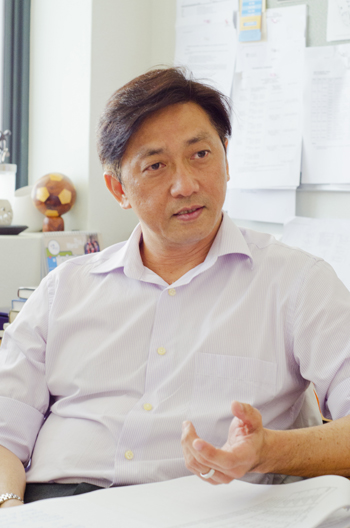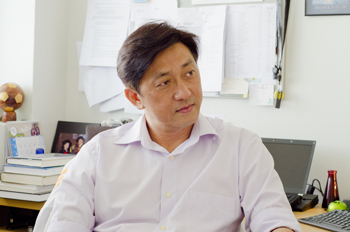Creating a Good Learning Environment
For teachers, creating a learning environment where students become self-motivators requires some thought and time, but the students will enjoy the lessons more, and work harder too.
“Teachers, being professionals, will always seek better outcomes for students,” says Assistant Professor Eugene Chew of NIE’s Physical Education and Sports Science Academic Group.
For his project on motivation in Physical Education (PE) lessons, Eugene is looking at students’ perceptions of how their PE teachers relate to them. This has an effect on whether they enjoy PE, and how much effort they are willing to put into their lessons.
Conditional Regard from Teachers
 To Eugene, motivation is an intriguing part of human behaviour. This is because different individuals could be motivated for very different reasons. In his study, he looks at the “conditional regard” that PE teachers give their students.
To Eugene, motivation is an intriguing part of human behaviour. This is because different individuals could be motivated for very different reasons. In his study, he looks at the “conditional regard” that PE teachers give their students.
Conditional positive regard reflects the approval that a teacher shows to students who meet expectations, such as more demonstrations of warmth and appreciation than usual.
Conditional negative regard is the opposite, when those who do not perform to expectations receive less attention and affection than usual.
Previous research has shown that parents’ use of conditional positive regard is associated with negative outcomes.
Why is this so? Eugene says that some students who receive such appreciation and affection are driven by motivation that is controlled and extrinsic. In other words, they feel that they are doing what someone else wants them to do, and not doing it because they want to.
“If the students feel they are being controlled in terms of what they do, it’s not really up to them and they don’t see it as important or see the value in it,” Eugene says. Hence, he thought that PE teachers’ use of conditional positive regard will also be linked to negative outcomes.
It’s about creating a good learning environment where students will be able to be at ease and able to learn.
– Eugene Chew, Physical Education and Sports Science Academic Group
Instead, what he found was students who perceive conditional positive regard from teachers during PE lessons were more interested and put in more effort. What could explain this?
Students did feel they were being told what to do, and experienced mixed feelings about teachers’ use of conditional positive regard. But they generally felt positive about the approval and attention shown by their teachers.
Setting the Right Tone
There are other things teachers can do to motivate their students. to To help them become self-motivating learners, teachers must set the right tone for their lessons. “It’s about creating a good learning environment where students will be able to be at ease and able to learn,” says Eugene.
“We’re talking about encouraging learning and engaging students better,” he continues. “It’s the whole manner in which they communicate with students, including body language and the tone of their voice.”
Besides this, Eugene also advises teachers to let students know why their PE lessons are planned in a certain way to help them understand what they can get out of it.
Meeting Students’ Psychological Needs
When doing lesson plans, teachers often work with the learning outcomes in mind. But they could also think of student motivation as a goal.
Eugene says that according to self-determination theory, everyone has three psychological needs that need to be fulfilled for them to feel motivated. Teachers can aim to meet students’ needs for autonomy, competency and relatedness as part of the lessons.
Need for autonomy
The need for autonomy is the need to have a sense of volition in one’s action. Presenting choices to students can help support this need. In a PE lesson, teachers can craft an activity where students are given choices instead of having every student do an activity in a specified way. Or teachers can ask students to choose from three pre-planned sports activities they would like to engage in.
Giving students a choice is a powerful way of giving them agency in their learning, motivating them to look forward to the next activity of their choice.
Need for competency
The need for competency is the need to experience mastery over one’s environment. For students, it may mean being able to master a certain skill or content. Eugene talks about how there are two types of goals that teachers can set for students: mastery and performance goals.
Mastery goals make people want to learn, while performance goals encourage competition. For example, teachers can get students to either better their own timing in running or make them race against their peers and then compare performances.
Becoming competent is a great motivator for students to continuously improve their mastery of a skill or an area of knowledge.
Need for relatedness
The need for relatedness is a basic need to belong or be cared for. For this, teachers can strive to promote positive interactions with and among students.
Getting students into groups and asking them to work together for a common goal is one good way to establish relatedness.
Motivating the Unmotivated
In every class, there will always be students who feel unmotivated. How can a teacher help such individuals?
“You will look at the next level of engagement,” says Eugene, referring to the interactions a teacher can have with them outside of lesson time.
It might be a one-to-one talk after class, during recess or even along the corridor. That is when the teacher can understand more about a student’s background.
Even just asking the student, “How was your game yesterday?” can go a long way in building teacher-student bonds.
There is a lot more that can be done to motivate students. Eugene thinks that the work researchers do will be helpful for both policymakers and educators.
“I would love to speak and interact more with educators, especially school leaders,” says Eugene. “There are findings that are already there that can be used straight away. If there are more interactions that exist (among the researchers and educators), that’d be great!”







